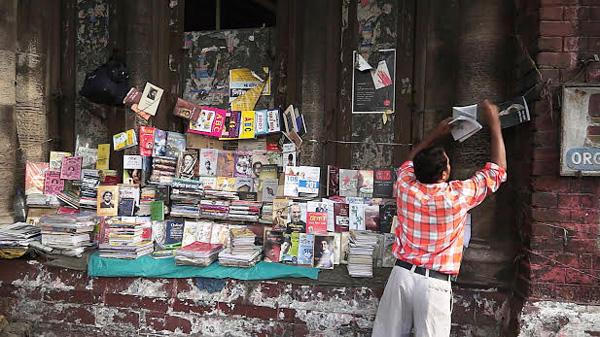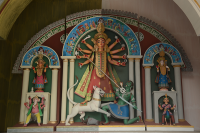 nil
nil
Little things matter
Little magazines, often called small magazines,, publish experimental and non-conformist writings by relatively unknown but dedicated writers. West Bengal is known for its great volume of little magazines. Two filmmakers, Abhijoy Karlekar and Utpal Basu examine the phenomenon through a documentary called Little Magaziner Katha. Shoma A. Chatterji reports
The history of literature for public consumption in the shape of magazines, newspapers and so on has a place for a different genre of publications – Little M agazines. Their agenda is free of profit motives and depends on a loyal readership.
In India, the Little Magazine movement took shape in the 50s and the 60s in many regional languages like Bengali, Tamil, Marathi, Hindi, Malayalam and Gujarati, as it did in the West, where it started in the early part of the 20th century. Among them little magazines in West Bengal tells a different story- full of colour, music, sound, and exclusive corners in book fairs devoted to this genre of publications..jpg)
The director duo Abhijoy Karlekar and Utpal Basu’s documentary film Little Magaziner Katha, produced by Shape, captures the contemporary history of the little magazine in Bengal. The film encompasses every genre of literature – “poetry, short stories, cultural investigation, society and politics, linguistics, environment, public health and science – a live sample of the astonishing variety of the little magazine oeuvre that is impossible to render in any single account,” says Karlekar.
Sandip Dutta, librarian, Little Magazines Library and Research Centre located in the north Kolkata where all the intellectual writings are said to have taken birth, traces the history of little magazines in Bengal to around 1818 when, between two magazines Digdarshan and Bangadarshan, around 172 small and big magazines were being published. “Not all of them were centered on literature. There were magazines focussed on religion, philosophy, politics, etc. The 19th century could be defined as the era of creation and construction. This was the age when the individual was taking shape,” says Datta. The little magazine genre helped this mood to thrive.
Why are they called ‘little magazines’? Some little magazines on poetry that came out in the 70s were little in size and volume. ‘Little’ therefore is more metaphorical than literal. Most little magazines have a normal format that do not draw revenue from advertisements, do not run on profit, do not pay its contributors and the staff works out of a sense of commitment. Its founders and functionaries have a regular f income from other sources and work on the magazine after working hours. “It (little magazine) observes a culture of intellectual creativity and curiosity allied to disciplined, voluntary and collaborative work in a mode where commercial reward is not the goal. It is a ‘life of the mind’ flowing outside the banks of media and mainstream publishing,” say Karlekar and Basu.
Anindyo Bhattacharjee, graphic designer and illustrator, is dedicated to the little magazine genre and explains that it is now modernised to fit the computer age. “The biggest event that changed the entire dynamics of communication between and among people was the introduction of the Internet in 1995. This has been a revolutionary change, and the little magazine was no exception.” he says. He points out that if one looks back at the 1990s it was a decade of tremendous change not only across the world but also in India. The 1990s has perhaps seen the most dramatic metamorphosis of the world. The Soviet Union collapsed. The Tiananmen Square tragedy redefined the language and expression of students’ revolt; socialism had brought in its share of disillusionment. Along with that Indian ushered in the era of economic liberalization.
Shankar Prasad Dnere brings out a little magazine from Akrur Dutta Lane in the north Kolkata. The magazine is called Jele Padar Shong. Shong suggests the artist who performs a comic routine of skits and small pieces dressed up in different disguises or vesh for a rural audience as an unique form of entertainment. Jele Pada means a neighbourhood of fishermen. “In the city of Kolkata also, each neighbourhood has its own shong such as the Taltala shong, the Kansaripadashong, the Kidderpore shong and so on. Folk poets like Rupchand Pakshi and Gopal Ude began to compose rhymes on these performers. “We have given this name to our magazine to pay tribute to the marginal people in our society such as the sweeper, the travelling salesman, the street vendor etc. who used sing along as they worked. They project a completely unique and different culture. We are trying to bring out and sustain their culture for our readers,” says Dnere.
The countdown to an issue printed on schedule, or in time for the famous Book Fair of Kolkata provides a framework for portraying the love for literature and ideas, the socio-cultural commitment, the stretching of limited resources and the last-minute tensions that go into bringing out the magazines – year after year.
Little Magaziner Katha strips itself of the need for a commentary or an anchor person to hold the many strands of the story together. It is also a road movie as the camera journeys into different spaces and places in Kolkata and across West Bengal opening up a world we know little about. The camera travels from the localities like College Street Boi Para – the hub of books – through Patiram Book Stall, Little Magazine Library, Ultadanga, and so on, scanning the wide range of little magazines that are alive and kicking. The directors have only focussed on ambient sound to give the film a real feel.
“Though a majority of featured magazines in the film are from Kolkata, the story travels to events, publications and personalities in Purulia, Bardhaman, Medinipur and Jalpaiguiri districts,” the directors inform. They have interviewed people ranging from writers, readers, illustrators, publishers and printers etc. to make Little Magaziner Katha showcase a world of intellectual and creative impulses that does not necessarily look for commercial gratification, something unusual indeed in a world dominated by the rat race today.
Top Headlines
-
Art and Culture
Saptak Music School of Pittsburgh hosts spellbinding evening of Indian classical music
September 23, 2025
-
Art and Culture
Zigzag to clarity: Sonal Mansinghs dance of life captivates Delhi
September 08, 2025
-
Art and Culture
USA: Santoor Ashram Kolkata mesmerises Los Angeles with a celebration of Indian classical music
August 27, 2025
-
Art and Culture
'Feels like a tonic in my musical pursuits': Flute virtuoso Pandit Ronu Majumdar receives Padma Shri
June 06, 2025
-
Art and Culture
Of Paris, a chronic pain and a pivotal friendship: Frida Kahlo meets Mary Reynolds at the Art Institute of Chicago
April 16, 2025
-
Art and Culture
Prabha Khaitan Foundation celebrates 'Vasant Utsav' at Indian Museum Kolkata
March 15, 2025
-
Art and Culture
Musical concert 'Ami Bhalobashi Bangla Ke' to be held in Kolkata on April 19
February 20, 2025
-
Art and Culture
A kiss in front of The Kiss? Vienna museum's V-Day offer is ode to Klimt's artistic masterpiece
February 10, 2025
-
Art and Culture
Dalhousie Square: Timekeeping with Kolkata's British gems
January 12, 2025
-
Art and Culture
Annapurna Devi: An absent protagonist
January 11, 2025

